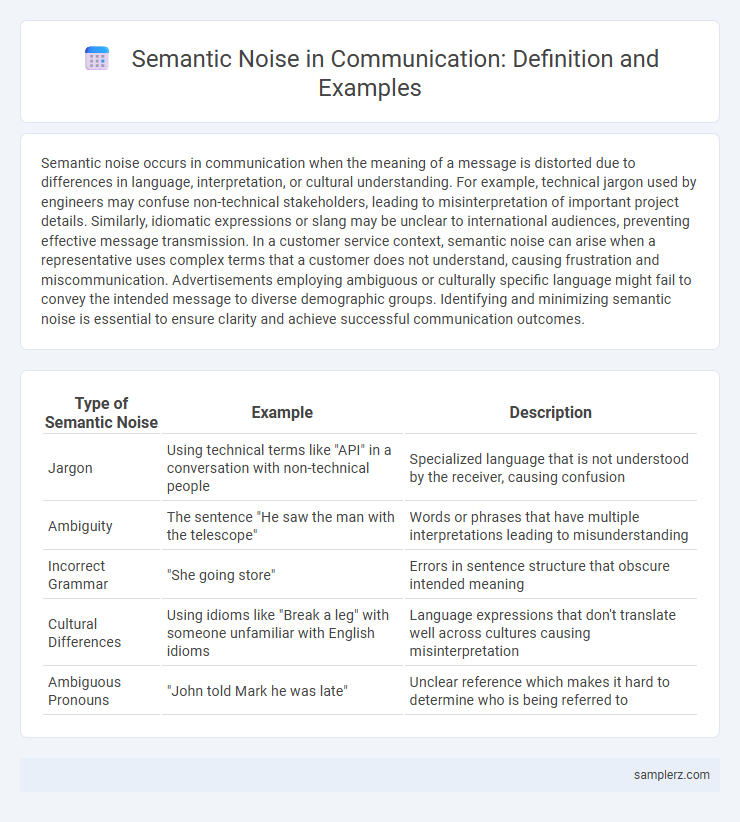Semantic noise occurs in communication when the meaning of a message is distorted due to differences in language, interpretation, or cultural understanding. For example, technical jargon used by engineers may confuse non-technical stakeholders, leading to misinterpretation of important project details. Similarly, idiomatic expressions or slang may be unclear to international audiences, preventing effective message transmission. In a customer service context, semantic noise can arise when a representative uses complex terms that a customer does not understand, causing frustration and miscommunication. Advertisements employing ambiguous or culturally specific language might fail to convey the intended message to diverse demographic groups. Identifying and minimizing semantic noise is essential to ensure clarity and achieve successful communication outcomes.
Table of Comparison
| Type of Semantic Noise | Example | Description |
|---|---|---|
| Jargon | Using technical terms like "API" in a conversation with non-technical people | Specialized language that is not understood by the receiver, causing confusion |
| Ambiguity | The sentence "He saw the man with the telescope" | Words or phrases that have multiple interpretations leading to misunderstanding |
| Incorrect Grammar | "She going store" | Errors in sentence structure that obscure intended meaning |
| Cultural Differences | Using idioms like "Break a leg" with someone unfamiliar with English idioms | Language expressions that don't translate well across cultures causing misinterpretation |
| Ambiguous Pronouns | "John told Mark he was late" | Unclear reference which makes it hard to determine who is being referred to |
Understanding Semantic Noise in Communication
Semantic noise in communication occurs when the meaning of words or phrases is misunderstood due to differences in language, jargon, or cultural interpretations. For example, technical terms used by experts may confuse a general audience, leading to misinterpretation or loss of the intended message. Recognizing and minimizing semantic noise enhances clarity and ensures effective information exchange between communicators.
Common Causes of Semantic Noise
Semantic noise in communication often arises from ambiguous language, jargon, or technical terms that the receiver does not understand. Misinterpretation can occur when cultural differences affect the meaning of words or phrases, leading to confusion. Poor word choice, slang, and idiomatic expressions also contribute to semantic barriers that disrupt message clarity.
Real-Life Examples of Semantic Noise
Semantic noise occurs when the meaning of a message is misunderstood due to language differences or ambiguous words, such as a technical term confusing a layperson during a workplace meeting. A real-life example is a doctor using medical jargon with patients who fail to grasp important health information, leading to miscommunication. Another instance is when cultural idioms or slang in a message create confusion among international team members, disrupting effective communication.
Impact of Jargon on Message Clarity
Jargon creates semantic noise by introducing specialized terms that obscure the intended message, leading to misunderstandings between the sender and receiver. When technical language is unfamiliar to the audience, the clarity of communication is compromised, reducing the effectiveness of information exchange. This barrier often results in confusion, misinterpretation, and a breakdown in communication flow.
Ambiguity and Multiple Meanings in Language
Semantic noise in communication arises when words or phrases carry ambiguity and multiple meanings, causing confusion between sender and receiver. For example, the word "bat" can refer to a flying mammal or a piece of sports equipment, leading to misinterpretation. This ambiguity disrupts message clarity and hampers effective understanding in conversations.
Cultural Differences and Semantic Barriers
Semantic noise in communication often arises from cultural differences where words or phrases carry distinct meanings across languages or social contexts, leading to misinterpretation. For example, idiomatic expressions common in one culture may be completely misunderstood or offensive in another, creating barriers to effective communication. Such semantic barriers impede clarity, reduce message accuracy, and contribute to communication breakdowns in multicultural interactions.
Misinterpretation Due to Slang and Idioms
Semantic noise in communication often arises from the misinterpretation of slang and idioms, which vary widely across cultural and regional contexts. For example, phrases like "break a leg" or "spill the beans" may confuse non-native speakers, leading to misunderstandings that disrupt the intended message. This type of semantic barrier highlights the importance of clear, context-aware language to ensure effective communication.
Semantic Noise in Digital Communication
Semantic noise in digital communication occurs when ambiguous language or jargon leads to misunderstandings between sender and receiver. For example, using technical terms like "API" or "cache" without clarifying their meaning can confuse users unfamiliar with these concepts. This disruption hampers effective information exchange on platforms such as emails, social media, or instant messaging.
Overcoming Semantic Noise in Conversations
Semantic noise in communication occurs when words or phrases are misunderstood due to ambiguous language or differences in interpretation. Overcoming semantic noise involves using clear, precise language and confirming understanding through feedback, such as asking clarifying questions or paraphrasing. Enhancing vocabulary alignment and context awareness between participants reduces misinterpretations and improves effective message exchange.
Strategies for Reducing Semantic Barriers
Semantic noise occurs when language differences, ambiguous terms, or jargon obstruct clear understanding in communication. Employing strategies such as using simple and precise language, providing clear context, and encouraging feedback effectively reduces semantic barriers. Ensuring message clarity by avoiding idioms and technical terms also enhances mutual understanding and minimizes misinterpretation.

example of semantic noise in communication Infographic
 samplerz.com
samplerz.com